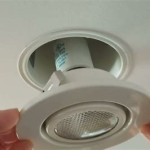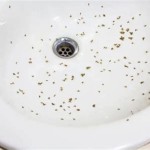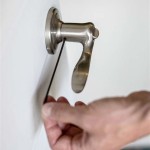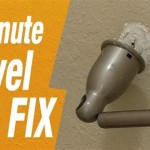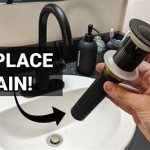How To Replace A Delta Single Handle Bathroom Sink Faucet Cartridge
A dripping faucet is a common household nuisance that can lead to wasted water and increased water bills. Often, the culprit behind a persistent drip in a Delta single handle bathroom sink faucet is a worn-out cartridge. Replacing the cartridge is a relatively straightforward plumbing repair that most homeowners can accomplish with basic tools and a little patience. This article provides a comprehensive guide on how to replace a Delta single handle bathroom sink faucet cartridge, ensuring a leak-free fixture.
Identifying the Correct Cartridge
Before embarking on the replacement process, it is crucial to identify the correct cartridge for the specific Delta faucet model. Delta utilizes various cartridge designs, and using the wrong one will prevent proper functionality and potentially damage the faucet. The first step is to locate the faucet model number. This number is often found on the original faucet packaging, the installation instructions, or sometimes stamped on the faucet body itself, usually beneath the sink. If the model number is unavailable, a visual comparison of the existing cartridge with diagrams and images available on the Delta website or at local hardware stores can help narrow down the options.
Once the model number is determined or a visual match is confirmed, the appropriate replacement cartridge can be purchased from a plumbing supply store, hardware store, or online retailer. Ensure the replacement cartridge is specifically designed for Delta single handle bathroom sink faucets. Confirming compatibility before purchase will save time and prevent frustration. Some replacement cartridges are universal and fit a range of Delta models, while others are model-specific. Carefully read the product description or consult with a sales associate to ensure the correct cartridge type is selected.
It is also advisable to purchase a cartridge puller tool. While not strictly essential, this tool is designed to grip and remove stubborn cartridges that have become lodged in the faucet body due to mineral buildup or corrosion. Attempting to remove a stuck cartridge without the proper tool can result in damage to the faucet body or the cartridge itself, making removal even more difficult. A cartridge puller is a worthwhile investment, especially for older faucets.
Preparing for the Replacement
Proper preparation is essential for a smooth and successful cartridge replacement. The first step is to shut off the water supply to the faucet. Locate the shut-off valves under the sink, typically one for hot water and one for cold water. Turn both valves clockwise until they are fully closed. If the shut-off valves are corroded or do not function properly, the main water supply to the house may need to be turned off. This is usually located in the basement, garage, or near the water meter. Once the water supply is shut off, turn on the faucet to relieve any remaining pressure in the lines.
Next, gather the necessary tools and materials. These usually include: a new Delta faucet cartridge, a cartridge puller (optional), a flathead screwdriver, a Phillips head screwdriver, an Allen wrench (size may vary depending on the faucet model), a pair of pliers, a small container (such as a cup or bowl), a clean cloth or sponge, and white vinegar (optional, for cleaning mineral deposits). Having all the tools readily available will streamline the process and prevent unnecessary delays.
Protect the sink and surrounding area from scratches and damage by placing a towel or drop cloth around the faucet base. This will also help to catch any water or debris that may spill during the replacement process. Good lighting is also essential. Ensure the work area is well-lit, either with natural light or a portable work light. Clear the area under the sink of any obstructions to provide ample room to work comfortably.
Step-by-Step Cartridge Replacement
With the preparations complete, proceed with the cartridge replacement itself. The specific steps may vary slightly depending on the faucet model, but the general procedure remains consistent. Begin by removing the faucet handle. The handle is typically secured by a set screw, located on the side or back of the handle. Use an Allen wrench to loosen the set screw. Once loosened, the handle should slide off easily. If the handle is stuck, gently rock it back and forth while pulling upwards.
After removing the handle, the next step is to remove the decorative cap or escutcheon that covers the cartridge. This cap is usually made of chrome or plastic and may be threaded or held in place by a small screw. Use a flathead screwdriver to carefully pry off the cap or unscrew it. Be careful not to scratch or damage the finish of the faucet. Once the cap is removed, the cartridge retaining clip or nut will be visible. This clip or nut secures the cartridge in place and prevents it from moving.
Use pliers or an adjustable wrench to carefully remove the retaining clip or nut. Note the orientation of the clip or nut before removing it, as it will need to be reinstalled in the same way. With the retaining clip or nut removed, the old cartridge should now be accessible. If the cartridge is loose, it may simply slide out. However, in many cases, the cartridge will be stuck due to mineral buildup or corrosion. This is where the cartridge puller tool becomes invaluable. Attach the cartridge puller to the cartridge according to the tool's instructions and use it to gently pull the cartridge out of the faucet body. If a cartridge puller is unavailable, try gently rocking the cartridge back and forth while pulling upwards. Avoid using excessive force, as this could damage the faucet body.
Once the old cartridge is removed, inspect the inside of the faucet body for any debris or mineral deposits. Use a clean cloth or sponge to wipe out the inside of the faucet body. For stubborn mineral deposits, soak a cloth in white vinegar and use it to scrub the affected areas. Ensure the inside of the faucet body is clean and free of any obstructions before installing the new cartridge.
Lubricate the O-rings on the new cartridge with silicone grease or plumber's grease. This will help to ensure a proper seal and prevent leaks. Insert the new cartridge into the faucet body, aligning it with the orientation marks on the faucet body. Ensure the cartridge is fully seated and pushed all the way in. Reinstall the retaining clip or nut, making sure it is properly aligned and tightened securely. Replace the decorative cap or escutcheon and tighten the screw if applicable. Finally, reinstall the faucet handle and tighten the set screw. The handle should move smoothly and easily.
After completing the reassembly, slowly turn the water supply back on, first the hot water and then the cold water. Check for any leaks around the faucet base, handle, and spout. If any leaks are detected, turn off the water supply and carefully inspect the connections. Make sure all parts are properly aligned and tightened. If the leaking persists, it may be necessary to disassemble the faucet and inspect the O-rings and seals for damage. If all connections are leak-free, run the faucet for a few minutes to flush out any air or debris from the lines. The faucet should now operate smoothly and without any drips.
Troubleshooting Common Issues
While the cartridge replacement process is often straightforward, some common issues may arise. If the new cartridge does not stop the dripping, double-check that the correct cartridge was installed for the specific faucet model. An incorrect cartridge will not seal properly and will continue to leak. Also, ensure the cartridge is fully seated and the retaining clip or nut is securely tightened. If the cartridge is not fully seated, it will not create a proper seal.
If the faucet handle is difficult to turn after installing the new cartridge, the cartridge may be too tight or the O-rings may not be properly lubricated. Remove the handle and cartridge, apply more silicone grease to the O-rings, and reinstall the cartridge. Ensure the cartridge is aligned properly and not forced into position. If the handle still does not turn smoothly, the cartridge may be defective and need to be replaced. Occasionally the handle will be stiff to turn due to pressure. Turning the water off and on again sometimes resolves this issue.
If the water flow is restricted after installing the new cartridge, there may be debris blocking the cartridge or the aerator. Remove the aerator and clean it thoroughly. Also, remove the cartridge and inspect the inside of the faucet body for any debris. Flush the faucet lines by turning on the water supply with the cartridge removed. This will help to dislodge any debris that may be blocking the water flow. Reinstall the cartridge and aerator, and check the water flow.
If the spout drips intermittently after the cartridge replacement, air may be trapped in the water lines. Run the faucet for several minutes to allow the air to escape. Turning the water supply off and on again may also help to release trapped air. If the dripping persists, inspect the cartridge for any damage or defects. A damaged cartridge may not seal properly and will continue to drip. In rare cases, the faucet body itself may be damaged, requiring replacement of the entire faucet.

How To Replace The Cartridge In A Single Handle Delta Faucet Repair

How To Rebuild A Delta Single Handle Faucet

Easy Fix Delta Faucet Drip Repair

Replace Cartridge On A Single Handle Pfister Bathroom Faucet Free Replacement

Simple Ways To Fix A Leaky Delta Bathroom Sink Faucet

Delta Single Handle Faucet Cartridge Replacement

Simple Ways To Fix A Leaky Delta Bathroom Sink Faucet

How To Replace A Cartridge In Faucet The Home Depot

Repair Parts For One And Two Handle Delta Bathroom Faucets

Shower Faucet Repair Advocate Master Plumbing
Related Posts
